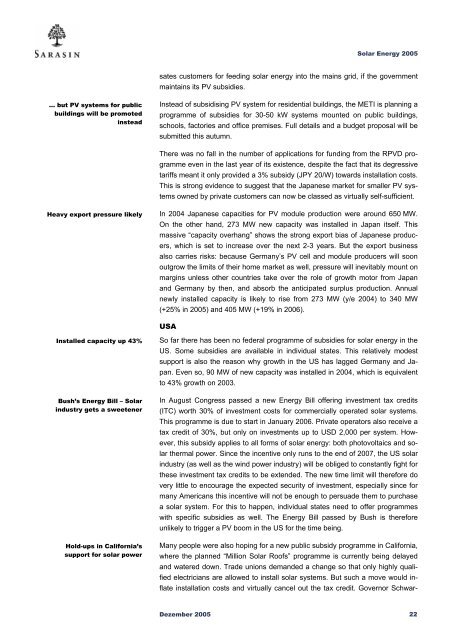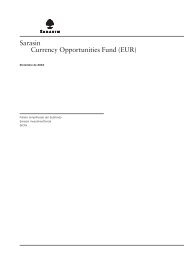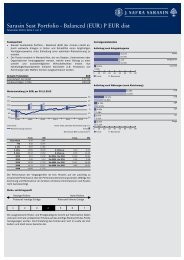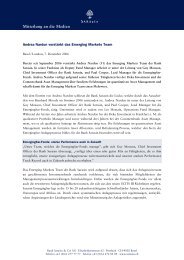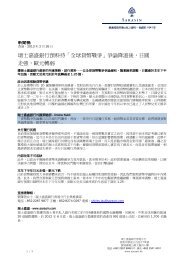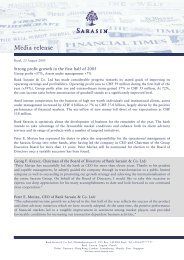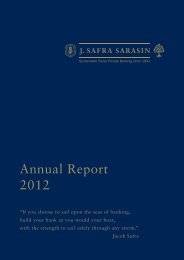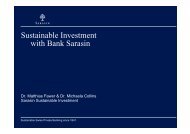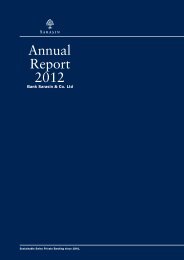Sustainability Report - Bank Sarasin-Alpen
Sustainability Report - Bank Sarasin-Alpen
Sustainability Report - Bank Sarasin-Alpen
Create successful ePaper yourself
Turn your PDF publications into a flip-book with our unique Google optimized e-Paper software.
Solar Energy 2005<br />
sates customers for feeding solar energy into the mains grid, if the government<br />
maintains its PV subsidies.<br />
… but PV systems for public<br />
buildings will be promoted<br />
instead<br />
Instead of subsidising PV system for residential buildings, the METI is planning a<br />
programme of subsidies for 30-50 kW systems mounted on public buildings,<br />
schools, factories and office premises. Full details and a budget proposal will be<br />
submitted this autumn.<br />
There was no fall in the number of applications for funding from the RPVD programme<br />
even in the last year of its existence, despite the fact that its degressive<br />
tariffs meant it only provided a 3% subsidy (JPY 20/W) towards installation costs.<br />
This is strong evidence to suggest that the Japanese market for smaller PV systems<br />
owned by private customers can now be classed as virtually self-sufficient.<br />
Heavy export pressure likely<br />
In 2004 Japanese capacities for PV module production were around 650 MW.<br />
On the other hand, 273 MW new capacity was installed in Japan itself. This<br />
massive “capacity overhang” shows the strong export bias of Japanese producers,<br />
which is set to increase over the next 2-3 years. But the export business<br />
also carries risks: because Germany’s PV cell and module producers will soon<br />
outgrow the limits of their home market as well, pressure will inevitably mount on<br />
margins unless other countries take over the role of growth motor from Japan<br />
and Germany by then, and absorb the anticipated surplus production. Annual<br />
newly installed capacity is likely to rise from 273 MW (y/e 2004) to 340 MW<br />
(+25% in 2005) and 405 MW (+19% in 2006).<br />
USA<br />
Installed capacity up 43%<br />
Bush’s Energy Bill – Solar<br />
industry gets a sweetener<br />
Hold-ups in California’s<br />
support for solar power<br />
So far there has been no federal programme of subsidies for solar energy in the<br />
US. Some subsidies are available in individual states. This relatively modest<br />
support is also the reason why growth in the US has lagged Germany and Japan.<br />
Even so, 90 MW of new capacity was installed in 2004, which is equivalent<br />
to 43% growth on 2003.<br />
In August Congress passed a new Energy Bill offering investment tax credits<br />
(ITC) worth 30% of investment costs for commercially operated solar systems.<br />
This programme is due to start in January 2006. Private operators also receive a<br />
tax credit of 30%, but only on investments up to USD 2,000 per system. However,<br />
this subsidy applies to all forms of solar energy: both photovoltaics and solar<br />
thermal power. Since the incentive only runs to the end of 2007, the US solar<br />
industry (as well as the wind power industry) will be obliged to constantly fight for<br />
these investment tax credits to be extended. The new time limit will therefore do<br />
very little to encourage the expected security of investment, especially since for<br />
many Americans this incentive will not be enough to persuade them to purchase<br />
a solar system. For this to happen, individual states need to offer programmes<br />
with specific subsidies as well. The Energy Bill passed by Bush is therefore<br />
unlikely to trigger a PV boom in the US for the time being.<br />
Many people were also hoping for a new public subsidy programme in California,<br />
where the planned “Million Solar Roofs” programme is currently being delayed<br />
and watered down. Trade unions demanded a change so that only highly qualified<br />
electricians are allowed to install solar systems. But such a move would inflate<br />
installation costs and virtually cancel out the tax credit. Governor Schwar-<br />
Dezember 2005 22


